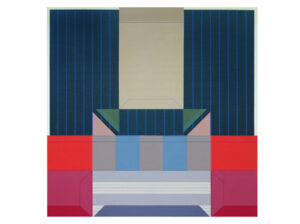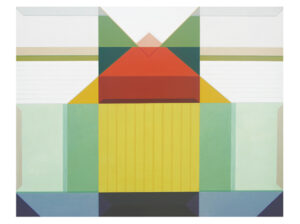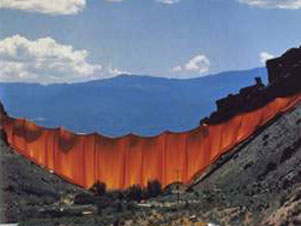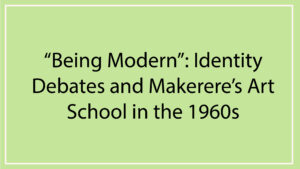Sunanda K Sanyal
(Catalog Essay, 2011)
In the 21st century, the question of any new contributions from abstract art is a complicated matter, for the Modernist baggage it carries can hardly be justified any more. And because of the curious mix of utopia and reason that once informed its rhetoric, the problem is more acute for geometric abstraction. From the individualist projects (Mondrian, Malevich in prewar Europe; Newman, Rothko in postwar America) to the collective enterprises (Russian Constructivism, German Bauhaus) of Modernism, geometric art was deeply grounded in a utopian vision of humanity. Since the Minimalist experiments of the 1960s, however, that myth of geometry’s quasi-sacred power has lost its potency; instead, it is now taken as a kind of codification of nature. In other words, there is really no triangle or pyramid underlying a mountain, or a cube underlying a box, except in the beholder’s perception, which is itself thoroughly conditioned by a specific culture. Therefore, in the media-saturated cotemporary visual culture, where heterogeneity of vision is celebrated, the notion that painted geometric shapes on canvas are authentic symbols of the painter’s vision of a homogeneous humanity is simply untenable.
And yet, geometric abstraction as a pictorial strategy is far from extinct; and as evidence of his strong conviction to art, Subir Hati’s canvases are dazzling spectacles indeed. Even though —for reasons irrelevant in this context— India’s modern art never had a strong legacy of abstraction, Hati is resolutely committed to a sort of geometric art that he has rigorously crafted. How, then, does one interpret his work within the wider context of abstract art? Since I find Hati’s verbalisms often incompatible with his images, I rely more on the latter in critiquing his work. I am not uneasy at all with this position; for art criticism has never simply been an expository enterprise, dependant on a happy consensus between the artist and the critic. Rather, divergence of interpretation —often sharp and antagonistic— is what makes discussion of art provocative and instructive, deferring any finality of meaning.

The singularly defining element in Hati’s work is the almost obsessive mathematical precision employed in the construction of pictorial space. The strict bilateral symmetry of all his paintings (which he calls “mirror image”) recalls the visual structure of the famous Rorschach’s inkblot test, even though the inkblots are hardly geometric. This symmetry has a two-fold impact. Split vertically, the two halves of a painting echo each other so diligently that the picture’s scale appears flexible: each image, it seems, could be magnified infinitely without any distortion of its compositional unity. Second, the bilateral structure keeps Hati’s cornucopia of color framed within carefully assigned spaces, which gives the images the feel of a prism— a device that offers access to the color spectrum via a specific structure.

Hati’s use of color follows two different strategies. While some of his images have numerous colored planes, others show strikingly economized surfaces, where only a limited number of geometric shapes rest within large planes of bright, flat shades. Such calculated balancing of structure and color immediately sparks two distinct memories in the beholder: architecture and textile. In some of the paintings, juxtaposed colored shapes —like radically transformed fragments of diagrams from an architect’s drawing-board— invoke visions of walls, roofs, post-and-lintels, and portals. Other images, where smaller, interlocked shapes actively interact with one another, recall richly designed fabrics. Despite their reductive abstraction, therefore, the paintings refer to tangibility; and it is in this paradox of pictoriality and objecthood that I see the relevance of Hati’s geometric images. An early example of this paradox is Malevich’s celebrated “White on White” (1918), which is, at the same time, a juxtaposition of two severely reduced abstract shapes and a tilted blank canvas on an immaculate wall. This symbiosis between two seemingly opposing notions of abstract images —referentiality (referring to something other than itself) and self-referentiality (referring to nothing but itself)— was more aggressively explored by Frank Stella and the Minimalists in postwar America. The prismatic character of Hati’s work has nothing of the pronounced austerity of Minimalism; but the ontological tension of his images —being exclusively pictorial and abstract, yet also defying that identity to embrace tangibility— re-presents in an intriguing way a contradiction that is a defining attribute of Minimalism.

 The illusory experience of Hati’s paintings, however, is also somewhat reminiscent of the complex visual puns of Synthetic Cubism. For instance, one is unsure if, what looks like a fold among the overlapped or juxtaposed planes is a collaged fold or an illusion of one; sharp diagonals sacrifice their flatness to become drastic foreshortenings; mild stripes over a dark surface momentarily present the background as a void; color contrasts between planes of various shades make the lighter ones recede. In other words, planes, which are essentially two-dimensional, here visually morph into spaces. Invoking textile and architecture, they seem to render abstraction itself as an illusion by identifying the canvas as an object. What is more, this question of tangibility is underscored by two other elements common to all the paintings: the strict symmetry that defines the boundaries of the canvas; and the extension of the painted patterns around the edges of the stretcher bar. By denying the frame, which conventionally defines a picture’s boundaries to signify its two-dimensionality, the latter strategy unequivocally transgresses the pictorial ontology to forcefully assert the tangibility of the image.
The illusory experience of Hati’s paintings, however, is also somewhat reminiscent of the complex visual puns of Synthetic Cubism. For instance, one is unsure if, what looks like a fold among the overlapped or juxtaposed planes is a collaged fold or an illusion of one; sharp diagonals sacrifice their flatness to become drastic foreshortenings; mild stripes over a dark surface momentarily present the background as a void; color contrasts between planes of various shades make the lighter ones recede. In other words, planes, which are essentially two-dimensional, here visually morph into spaces. Invoking textile and architecture, they seem to render abstraction itself as an illusion by identifying the canvas as an object. What is more, this question of tangibility is underscored by two other elements common to all the paintings: the strict symmetry that defines the boundaries of the canvas; and the extension of the painted patterns around the edges of the stretcher bar. By denying the frame, which conventionally defines a picture’s boundaries to signify its two-dimensionality, the latter strategy unequivocally transgresses the pictorial ontology to forcefully assert the tangibility of the image.
The prism metaphor effectively describes the paradoxical potential of Hati’s geometric paintings; for a prism, after all, is an object that offers a vision of colors contained by light, which itself travels through space to make the colors visible. In short, this magical piece of glass embodies both ethereality and tangibility. So the next logical step for Hati’s work, it seems to me, would be a more critical exploration of architecture and textile to shift farther from conventional painting into complex multimedia constructions. Such projects would certainly generate more provocative dialogs between two- and three-dimensionality, pictoriality and tangibility; and with regard to medium, between painting and sculpture.



